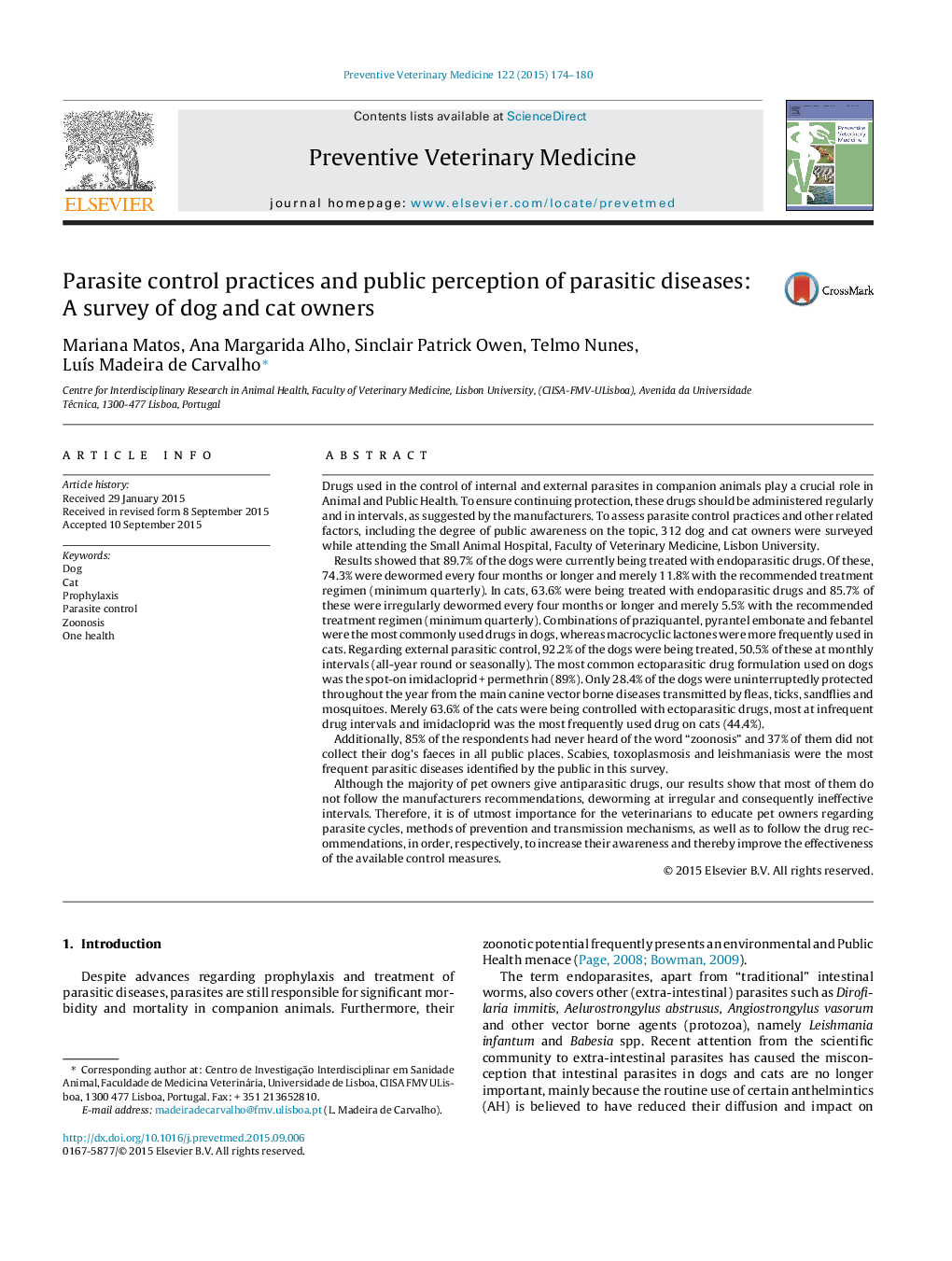| کد مقاله | کد نشریه | سال انتشار | مقاله انگلیسی | نسخه تمام متن |
|---|---|---|---|---|
| 5793084 | 1554166 | 2015 | 7 صفحه PDF | دانلود رایگان |
- Survey to assess parasite control practices and degree of dog and cat owner awareness on the topic.
- 89.7% of dogs were treated with endoparasitic drugs, 11.8% with quarterly treatment regimen. 63.6% of cats were treated, 5.5% with quarterly treatment regimen.
- Only 28.4% of the dogs were uninterruptedly protected throughout the year from the main ectoparasites and Canine Vector Borne Diseases.
- Majority of pet owners apply antiparasitic drugs, but deworm at irregular and ineffective intervals.
- Need to increase pet owner's awareness towards zoonosis and One Health.
Drugs used in the control of internal and external parasites in companion animals play a crucial role in Animal and Public Health. To ensure continuing protection, these drugs should be administered regularly and in intervals, as suggested by the manufacturers. To assess parasite control practices and other related factors, including the degree of public awareness on the topic, 312 dog and cat owners were surveyed while attending the Small Animal Hospital, Faculty of Veterinary Medicine, Lisbon University.Results showed that 89.7% of the dogs were currently being treated with endoparasitic drugs. Of these, 74.3% were dewormed every four months or longer and merely 11.8% with the recommended treatment regimen (minimum quarterly). In cats, 63.6% were being treated with endoparasitic drugs and 85.7% of these were irregularly dewormed every four months or longer and merely 5.5% with the recommended treatment regimen (minimum quarterly). Combinations of praziquantel, pyrantel embonate and febantel were the most commonly used drugs in dogs, whereas macrocyclic lactones were more frequently used in cats. Regarding external parasitic control, 92.2% of the dogs were being treated, 50.5% of these at monthly intervals (all-year round or seasonally). The most common ectoparasitic drug formulation used on dogs was the spot-on imidacloprid + permethrin (89%). Only 28.4% of the dogs were uninterruptedly protected throughout the year from the main canine vector borne diseases transmitted by fleas, ticks, sandflies and mosquitoes. Merely 63.6% of the cats were being controlled with ectoparasitic drugs, most at infrequent drug intervals and imidacloprid was the most frequently used drug on cats (44.4%).Additionally, 85% of the respondents had never heard of the word “zoonosis” and 37% of them did not collect their dog's faeces in all public places. Scabies, toxoplasmosis and leishmaniasis were the most frequent parasitic diseases identified by the public in this survey.Although the majority of pet owners give antiparasitic drugs, our results show that most of them do not follow the manufacturers recommendations, deworming at irregular and consequently ineffective intervals. Therefore, it is of utmost importance for the veterinarians to educate pet owners regarding parasite cycles, methods of prevention and transmission mechanisms, as well as to follow the drug recommendations, in order, respectively, to increase their awareness and thereby improve the effectiveness of the available control measures.
Journal: Preventive Veterinary Medicine - Volume 122, Issues 1â2, 1 November 2015, Pages 174-180
